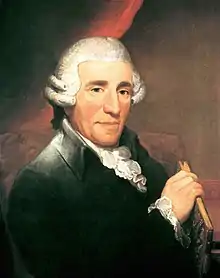Symphony No. 71 (Haydn)
The Symphony No. 71 in B flat major, Hoboken I/71, is a symphony by Joseph Haydn. It was composed by 1780.

Movements
The symphony is scored for flute, two oboes, bassoon, two horns and strings.
After dark string sonorities reminiscent of Sturm und Drang in the slow introduction, the Allegro begins with a very light galante theme which is interrupted periodically by more darkly colored strings. The transitional material is notable for its use of counterpoint.[1]
The slow second movement is a theme with four variations and a coda. The second variation features a flute and bassoon duet over thirty-second notes and pizzicato bass. Triplet-sixteenths dominate the third variation. As usual, the final variation is recapitulatory, but here Haydn extends the variation with further development and a cadenza-like passage.[1]
The trio of the minuet features solo sections for two violins against a pizzicato bass.[1]
Notes
- Brown, A. Peter, The Symphonic Repertoire (Volume 2). Indiana University Press (ISBN 025333487X), pp. 175–176 (2002).
References
- Haydn: Chronicle and Works, 5 vols, (Bloomington and London: Indiana University Press, 1976-) v. 2, Haydn at Eszterhaza, 1766-1790
- Oxford Composer Companions: Haydn, ed. David Wyn Jones, Oxford University Press, 2002. ISBN 0-19-866216-5